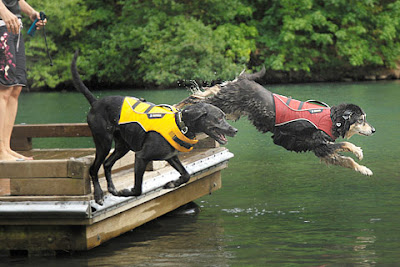Pet Water Safety
Water sports and recreation can be a terrific way to spend some quality fun time with your pet. Many dogs can enjoy the water for fun. Whether you’re considering taking your pooch on a boat, or to the ocean, lake, swimming pool, pond or ice, make sure you follow these simple common sense steps suggested by Dr. Pettit to keep your pet safe.
Pet Water Safety: Rated PG
Parental guidance or PG is the most important thing you can remember about pet water safety. Always supervise your pet near any body of water and be prepared to intervene if he/she gets into trouble.If it’s Not Safe for People, It’s Not Safe for Pets
Always obey warning signs such as “Do Not Swim,” “Beach Closed,” or “Thin Ice.” Such warnings represent as much danger for your pet as for you.Make Sure Your Dog Can Swim First
Not all dogs are natural swimmers. Those breeds with short legs, dense body conditions, and/or absent or cropped tails often find it difficult to stay afloat. Dogs with flat noses have a harder time breathing when in the water. Older dogs and those that are overweight may tire easily. Some dogs are even afraid of the water. Introduce your dog to water gradually in a controlled situation until you know he/she can swim.Make Sure the Water is Clean
Lakes, ponds and rivers may contain chemical contaminants, algae and bacteria or other microorganisms that can threaten your pet’s health through skin exposure or ingestion. Avoid any water that is discolored or smells bad, or is known to receive runoff from industry, farm activity or municipal sewage.Consider the Temperature
Cold water can quickly lower your pet’s body temperature and lead to hypothermia. If it is too cold for you, it is too cold for your pet. Also remember, extreme summer heat can lead to heat stroke for your pet.Keep Fresh Drinking Water Available
Pool water contains chlorine and other chemicals that can cause gastrointestinal upset if consumed in large quantities. Natural bodies of water can contain chemical poisons and infectious organisms. Encourage your pet to drink from your fresh water supply and he/she will be less likely to drink water that may be harmful.Consider Your Pet’s Health Conditions
Dogs that are prone to skin and ear infections should not be exposed to frequent swimming since chronic moisture can encourage such infections. While swimming is excellent exercise for the arthritic pet, don’t let him/her overdo it or he/she will be in pain afterward.Life Vests
Your pet should wear a life vest when in any body of water that is too deep for him/her to walk on the bottom. Any circumstance where it is advisable for a person to wear a life vest is one where your pet should wear it as well. Be sure it is sized and designed for a proper fit.First Aid Kit
Sharp objects such as stones, sea shells, fishhooks, glass or metal can lie unseen beneath the water, and cut your pet’s feet and legs. Keep a first aid kit on hand with a disinfectant such as iodine, an antibiotic ointment for superficial wounds, and sterile bandage material. Deep wounds should receive immediate medical attention.Stay Away from Thin Ice!
Even a small pet can fall through ice. Keep your pet o leash or voice control. If your pet does stray onto the ice, do not try to follow. If he/she falls in, call 911 for professional help. Once he/she is rescued, dry thoroughly, and wrap your pet in warm blankets. Seek immediate emergency care. Even brief exposure to very cold water can cause life-threatening hypothermia.Pool Safety
Chemicals in properly balanced pool water are generally safe for pets, although drinking a large amount of the water can cause gastrointestinal upset. Lead your pet to the stairs or steps and show him how to get out of the water. Once you know he/she is a comfortable swimmer, “startle” him into the water to be sure he/she can find his/her way out in an emergency situation.Ocean Safety
A properly fitted life vest is particularly important because pets can be pulled under by strong tides and undercurrents. Be aware of jellyfish and other sea animals that might be harmful for your pet, and observe all warnings regarding the presence of dangerous wildlife or dangerous water conditions.Boating Safety
Your pet may look cute perched on the bow of your boat, but dogs can fall off as easily as they fall out of pickup trucks! Make sure he/she is wearing a life vest, and is secured by a leash or crate when the boat is moving. This will prevent drowning or injury by the boat propellers.End with a Good Bath
After a day of swimming, bathe your pet with a mild shampoo to remove chlorine, sea salt and any other potential contaminants. Use an ear cleaner to rinse and dry the ears, and flush his/her eyes with sterile saline solution to prevent irritation.Talk to Your Veterinarian
Your veterinarian is an excellent source of advice about your particular pet and any special considerations for his/her safety during water recreation. He/she can advise you regarding eye, ear and skin care, as well as vaccinations to protect against certain water-borne diseases.Sleep Well!
Don’t be surprised if your pet is unusually tired after a day in the sun and the water. If your pet doesn’t swim often, he/she may seem stiff and sore, and your pet’s tail may appear “broken” the next day. Don’t worry—a little muscle soreness is to be expected after unaccustomed exercise. You may be feeling it too!All info in this blog post is from Healthy Pet.









0 comments:
Post a Comment